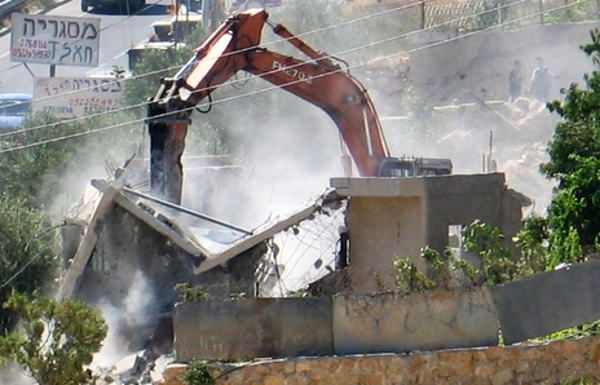by Natasha Roth
Israeli authorities have demolished more Palestinian homes in the occupied West Bank thus far in 2016 than in any other calendar year in the last decade, according to data provided by Israeli human rights NGO B’Tselem Wednesday and statistics from the UN humanitarian agency, OCHA.
B’Tselem’s statistics show that the Civil Administration, the Israeli military’s governing arm in the West Bank, destroyed 168 Palestinian homes between January 1 and June 30, 2016, displacing 740 people, including 348 children. A further 12 West Bank Palestinian dwellings were destroyed between July 1 and July 18, displacing a further 62 people, according to figures provided to +972 Magazine by OCHA. This brings the total for the year so far to at least 180 homes demolished — surpassing the previous high of the 175 dwellings destroyed in 2013.
Since 2006, B’Tselem reports, Israel has destroyed at least 1,113 Palestinian homes in the West Bank, not including punitive home demolitions. As a result, at least 5,199 Palestinians have been displaced, around half of whom are minors.
All of the demolitions have taken place in Area C, which is under full Israeli military security and administrative control. Israel justifies administrative demolitions by arguing that the structures in question have been built without a permit. However, it is almost impossible for Palestinians in Area C to obtain building permits: between 2010 and 2014 the army’s Civil Administration granted just 1.5 percent of requests. Moreover, the IDF recently admitted that when it comes to demolitions in the West Bank, “enforcement against Palestinians is hundreds of percentage points higher [than against Jews].”
There are currently around 11,000 outstanding demolition orders in Area C, affecting roughly 17,000 Palestinian structures — homes and others. Israel has issued 14,000 of these orders since 1988; as of the end of 2015, around 3,000 of these had been executed.
Nearly 60 percent of the demolition orders Israel has issued are hanging over structures belonging to communities in Area C that straddle the boundaries of areas A or B, a spatial distribution that is entirely deliberate. Almost all Israeli settlements are in Area C, and most Palestinian cities and larger towns are in areas A and B. The result is that major Palestinian population centers such as Nablus, Ramallah and Qalqiliyah have most, if not all, of their borders set by the reach of Area C territory, creating invisible walls around them. By issuing disproportionate numbers of demolition orders in Area C communities that straddle Areas A/B, the Civil Administration is ensuring those walls remain intact.
This pattern — of keeping Palestinians hemmed in invisible and visible urban cages — is, in a way, representative of the true story of the West Bank: one of structural violence, attrition and bureaucratic strangling. It is often argued by apologists for the occupation that Israel’s demolitions in Area C are a minor problem, because they “only” have the potential to affect around 300,000 Palestinians, out of some 2.8 million living in the entire West Bank.
But this is the inverse way of looking at the issue, because the flip-side is that over 2.7 million Palestinians are crammed into 40 percent of the West Bank, with nowhere to go — unless they leave. And as for those Palestinians living in Area C, Israel’s policies to push them off the land are manifold: in addition to demolitions, they are subject to military drills, expropriation of territory and plans for the expulsion of entire communities. The endgame of these overlapping processes is the annexation of Area C to Israel.
Back in January, Yesh Atid’s Yair Lapid — one of the faces of Israel’s political “center” — told an Israeli newspaper that hefavored “maximum Jews on maximum land with maximum security and with minimum Palestinians.” This adage, or versions of it, have been knocking around since before the founding of the State of Israel. The spate of demolitions in the West Bank — and around the rest of Israel-Palestine, whether in the Negev, Dahmash, Lod, or East Jerusalem — coupled with ethnically-driven relocation policies on both sides of the Green Line are the implementation of that racist vision.
Natasha Roth is writer, editor, and activist based in Jaffa. Her work has appeared in The London Review of Books Blog, Haaretz, The Daily Beast, and The Fair Observer. This article is reprinted, with permission, from +972 Magazine. Photo of house demolition in the West Bank by Andrew E. Larsen via Flickr.






Shame on Israel. Apartheid at its worst.
Apartheid? Where are the separate water fountains & bathrooms?
Why are there Arabs in the Israeli parliament & on the Israeli Supreme Court?
A man with a home, a job and children in education wil not want to go to war. That’s the way to pacify your enemies. Why doesn’t Israel know that?